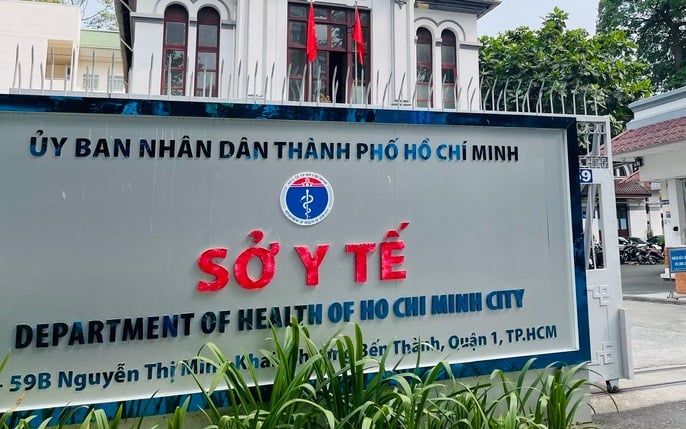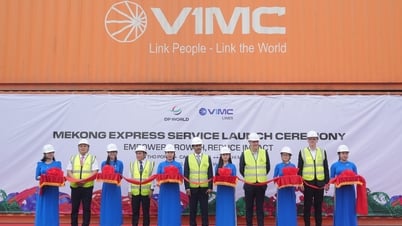The Ho Chi Minh City Department of Health has just coordinated with the Department of Health of Binh Duong province and the Department of Health of Ba Ria - Vung Tau province to organize the first workshop to evaluate the scale of health service provision after the merger of the three localities.
 |
| Illustration photo. |
The workshop took place with the permission of the Ho Chi Minh City People's Committee, marking the first time that senior leaders of the three Departments of Health jointly chaired and discussed to prepare for the merger of the health system, aiming to ensure the best health care services for nearly 14 million people across the merged area.
Here, delegates discussed many key issues related to the reorganization of the health system when the three localities merge. According to forecasts, after the merger, the administrative area of Ho Chi Minh City will increase from 2,095 km² to 6,772 km², the population will increase from 9.9 million to more than 13.7 million people.
This will lead to a sharp increase in the demand for health care in both quantity and scope. The number of hospitals will increase from 134 to 174, the number of beds will increase from 41,525 to 49,147, and the number of doctors will increase from 20,727 to 24,629.
However, the ratios of human resources and medical facilities per capita tend to decrease: hospital beds per 10,000 people decreased from 41.7 to 31.3; doctors per 10,000 people decreased from 20.8 to 13.08; nurses per 10,000 people decreased from 37 to 29 while the current targets are 42, 21 and 39 respectively.
The demand for medical examination and treatment is forecast to increase sharply. Outpatient visits may increase from more than 42 million to over 51 million visits/year, inpatient treatment from more than 2.2 million to more than 3.8 million visits/year.
With this scale, the merged Ho Chi Minh City healthcare system will handle about 30% of outpatient visits and more than 23% of inpatient treatments nationwide.
However, this also poses a great risk of overload for end-line hospitals in Ho Chi Minh City. To proactively respond, the health sector has proposed expanding the system according to the model of facilities 2 and 3 of leading hospitals in new areas of Binh Duong and Ba Ria - Vung Tau provinces.
This is not only a solution to reduce the load for Ho Chi Minh City but also an opportunity to develop a medical tourism model, exploiting the strengths of each locality in the new ecosystem.
The Ho Chi Minh City Health Department also proposed to supplement the health system development plan, forming the 4th and 5th specialized health clusters in Binh Duong and Ba Ria-Vung Tau.
At the same time, human resource and medical facilities indicators also need to be evaluated and adjusted to suit the new population size, avoiding a serious shortage of resources in the initial stages of consolidation.
One issue of particular concern is the implementation of out-of-hospital emergency services. Currently, Binh Duong and Ba Ria - Vung Tau do not have a developed out-of-hospital emergency system, so the Ho Chi Minh City Department of Health assigned the 115 Emergency Center to proactively survey and plan to expand the satellite emergency station network to these two provinces to ensure timely and effective service to the people.
Also within the framework of the workshop, the Ho Chi Minh City Department of Health reported on the implementation of the project to improve the capacity of the Ho Chi Minh City Center for Disease Control (CDC).
With its expanded scope of operations, the Center will be strengthened in both infrastructure and professional capacity to effectively fulfill its role in disease prevention and public health for the entire merged region.
Regarding public investment, the total investment capital for the Ho Chi Minh City health sector in the 2021-2025 period will increase from VND 48,549 billion to VND 52,424 billion, with a total of 154 projects (Ho Chi Minh City: 115; Binh Duong: 31; Ba Ria - Vung Tau: 8). In the 2026-2030 period, the total investment is expected to reach VND 65,134 billion.
In addition, there are 6 projects calling for investment in the form of public-private partnership (PPP) with a total capital of more than 10,000 billion VND. However, reality also shows that there are still some projects behind schedule or not put into effective use, requiring a fundamental solution in the management and coordination of public investment when the three Departments of Health merge.
Regarding the plan to reorganize the Ho Chi Minh City health system after the merger, delegates highly agreed with the draft presented by the Ho Chi Minh City Department of Health.
Accordingly, the functional departments of the three Departments will proactively establish specialized working groups to coordinate, develop and propose specific plans, ensuring no interruption of operations and improving efficiency in serving the people.
The second workshop is expected to be held on June 6, 2025 with the theme "Solutions to provide medical services to meet the health care needs of the City's people after the merger". This will be an opportunity for working groups to present specific solutions, complete the implementation plan and adjust it to suit the new situation.
The merger of the health care systems of three localities is not only a strategic step in administrative reform but also a golden opportunity to build a modern, sustainable, people-centered health care system, aiming to develop the country's leading urban area.
Also related to the merger of medical facilities, the Hanoi People's Committee has just issued a Plan to implement the Project "Improving the quality of medical examination and treatment of public medical facilities under the City People's Committee by 2030". This plan clearly defines the orientation of restructuring the public hospital system, investing in upgrading facilities, developing medical human resources and promoting comprehensive digital transformation in the medical sector.
Accordingly, the city will reorganize the public hospital system to streamline the apparatus, improve operational efficiency and quality of medical examination and treatment.
Specifically, Mai Huong Daytime Psychiatric Hospital will be merged into Hanoi Psychiatric Hospital, expected to be completed in the fourth quarter of 2025. At the same time, Hanoi Traditional Medicine General Hospital and Ha Dong Traditional Medicine Hospital will be merged into Hanoi Traditional Medicine General Hospital, expected to be completed in the fourth quarter of 2026.
In addition, Hanoi will also develop a project to establish new or reorganize existing medical facilities into basic hospitals in four key areas: Tay Ho, Hoang Mai, Thanh Xuan and Nam Tu Liem, contributing to the reasonable redistribution of the medical system, meeting the needs of health care by region.
Regarding infrastructure development investment, the city assigned relevant units to propose upgrading and expanding facilities and equipment for four major hospitals, including the Saint Paul General Hospital, Hanoi Oncology Hospital, Hanoi Heart Hospital and Hanoi Obstetrics and Gynecology Hospital. These projects will be implemented in the medium-term public investment plan for the period 2026-2030, with the goal of enhancing professional capacity and improving medical examination and treatment conditions for people.
The city is also planning to build two new specialized hospitals, the Geriatric Hospital and the Tropical Hospital. The selection of locations for these projects must be completed before May 31, 2025, and the project must be submitted for approval in the fourth quarter of 2025.
Along with reorganizing the hospital system and investing in infrastructure, the project also focuses on developing medical human resources in both quantity and quality.
The city aims to ensure a team of medical staff with solid expertise and good medical ethics, distributed reasonably between levels and regions. At the same time, it will improve the quality of professional techniques in medical examination and treatment through training, technology transfer and standardization of professional procedures.
Another key focus is comprehensive digital transformation in the healthcare sector, aiming to build a smart healthcare system. The city will deploy applications for remote monitoring, warning, and healthcare; establish online connections between patients, health monitoring devices, and healthcare workers.
In particular, electronic medical records will be put into synchronous use at medical examination and treatment facilities from the third quarter of 2025, contributing to improving management efficiency, reducing administrative procedures and increasing treatment accuracy.
Source: https://baodautu.vn/chuan-bi-hop-nhat-he-thong-y-te-sieu-do-thi-gan-14-trieu-dan-d288790.html


![[Photo] General Secretary To Lam receives Chief of the Central Office of the Lao People's Revolutionary Party](https://vphoto.vietnam.vn/thumb/1200x675/vietnam/resource/IMAGE/2025/5/30/140435f4b39d4599a3d17975dfb444c5)
![[Photo] Journalists moved to tears at the Memorial Service for the soldiers who died in Gac Ma](https://vphoto.vietnam.vn/thumb/1200x675/vietnam/resource/IMAGE/2025/5/30/9454613a55c54c16bf8c0efa51883456)
![[Photo] A delegation of 100 journalists from the Vietnam Journalists Association visits the soldiers and people of Truong Sa island district.](https://vphoto.vietnam.vn/thumb/1200x675/vietnam/resource/IMAGE/2025/5/30/0984a986227d4e988177f560d2e1563e)


![[Photo] National Conference "100 years of Vietnamese Revolutionary Press accompanying the glorious cause of the Party and the nation"](https://vphoto.vietnam.vn/thumb/1200x675/vietnam/resource/IMAGE/2025/5/30/1cf6cd5c8a934ebfa347028dcb08358c)





![[Video] Vietnam strives to master the technology to produce 15 types of vaccines by 2030](https://vphoto.vietnam.vn/thumb/402x226/vietnam/resource/IMAGE/2025/5/30/9b660538f5aa46daaff8b19dc9ca8204)














































































Comment (0)